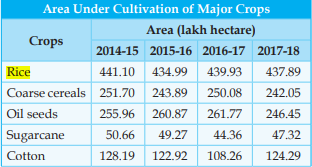Direct Seeding of Rice | 06 May 2022
For Prelims: Direct Seeding of Rice (DSR), Rice
For Mains: Irrigation, DSR
Why in News?
Recently, the Punjab government announced Rs 1,500 incentive per acre for farmers opting for Direct Seeding of Rice (DSR).
- In 2021, 18% (5.62 lakh hectares) of the total rice area in the state was under DSR against the government target of bringing 10 lakh hectares under it.
What is DSR and How is it Different from Normal Transplanting of Paddy?
- Transplanting Paddy:
- In transplanting paddy, farmers prepare nurseries where the paddy seeds are first sown and raised into young plants.
- The nursery seed bed is 5-10% of the area to be transplanted.
- These seedlings are then uprooted and replanted 25-35 days later in the puddled field.
- Direct Seeding of Rice (DRS):
- In DSR, the pre-germinated seeds are directly drilled into the field by a tractor-powered machine.
- There is no nursery preparation or transplantation involved in this method.
- Farmers have to only level their land and give one pre-sowing irrigation.
What is the need for DSR?
- During the transplanting of Paddy watering has to be done practically daily to ensure submerged/flooded conditions in the first three weeks.
- Under DSR, the first irrigation (apart from the pre-sowing) is necessary only 21 days after sowing.
- According to Punjab Agriculture Department data for last Kharif season (2021-22), 31.45 lakh hectares were under paddy and basmati.
- As per the studies, around 3,600 litres to 4,125 litres of water are required to grow one kg of rice depending upon the paddy variety.
- Long duration varieties consume more water.
- In Punjab, 32% of the area is under the long duration (around 158 days) paddy varieties, and the rest comes under paddy varieties that take 120 to 140 days to grow.
How much Water can DSR Save?
- According to an analysis, DSR technique can help save 15% to 20% water.
- In some cases, water saving can reach 22% to 23%.
- With DSR, 15-18 irrigation rounds are required against 25 to 27 irrigation rounds in traditional methods.
- DSR can save 810 to 1,080 billion litres of water every year if the entire rice crop is brought under the technique.
What are the Advantages of DSR?
- Require Less Number of Labours: DSR can solve labour shortage problems because like the traditional method it does not require a paddy nursery and transplantation of 30 days old paddy nursery into the main puddled field.
- Avenues for Groundwater: It offers avenues for ground water recharge as it prevents the development of hard crust just beneath the plough layer due to puddled transplanting.
- It matures 7-10 days earlier than the puddle transplanted crop, therefore giving more time for management of paddy straw.
- Increase in Yield: According to the results from research trials and farmers’ field survey, after this technique the yield is one to two quintals per acre higher than puddled transplanted rice.
What are the Disadvantages of DSR?
- Suitability: It is the most important factor as farmers must not sow it in the light textured soil as this technique is suitable for medium to heavy textured soils including sandy loam, loam, clay loam, and silt loam which accounts for around 80% area of the state.
- It is recommended to avoid this technique in fields which are under crops other than rice (like cotton, maize, sugarcane) in previous year as DSR in these soils is likely to suffer more from iron deficiency and weed problems.
- Laser and Levelling are Compulsory: The field should be laser levelled.
- Use of Herbicides: The spraying of herbicides must be done simultaneously along with sowing, and the first irrigation.
Rice
- Rice is a staple food for most of the population in India.
- It is a kharif crop which requires high temperature, (above 25°C) and high humidity with annual rainfall above 100 cm.
- In the areas of less rainfall, it is grown with the help of irrigation.
- In southern states and West Bengal, the climatic conditions allow the cultivation of two or three crops of rice in an agricultural year.
- In West Bengal farmers grow three crops of rice called ‘aus’, ‘aman’ and ‘boro’.
- About one-fourth of the total cropped area in India is under rice cultivation.
- Leading producer states: West Bengal, Uttar Pradesh, and Punjab.
- High Yielding States: Punjab, Tamil Nadu, Haryana, Andhra Pradesh, Telangana, West Bengal and Kerala.
- India is the second-largest producer of rice after China.
UPSC Civil Services Examination, Previous Year Questions (PYQs)
Q. With reference to the cultivation of Kharif crops in India in the last five years, consider the following statements: (2019)
- Area under rice cultivation is the highest.
- Area under the cultivation of jowar is more than that of oilseeds.
- Area of cotton cultivation is more than that of sugarcane.
- Area under sugarcane cultivation has steadily decreased.
Which of the statements given above are correct?
(a) 1 and 3 only
(b) 2, 3 and 4 only
(c) 2 and 4 only
(d) 1, 2, 3 and 4
Ans: (a)
- Hence, statements 1 and 3 are correct, and statements 2 and 4 are not correct. Therefore, option (a) is the correct answer.
Q. Consider the following crops: (2013)
- Cotton
- Groundnut
- Rice
- Wheat
Which of these are Kharif crops?
(a) 1 and 4
(b) 2 and 3 only
(c) 1, 2 and 3
(d) 2, 3 and 4
Ans: (c)
Q. Among the following, which one is the largest exporter of rice in the world in the last five years? (2019)
(a) China
(b) India
(c) Myanmar
(d) Vietnam
Ans: (b)

